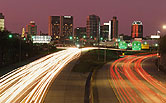
MONDAY, Jan. 24 (HealthDay News) — The reason that many older drivers have difficulty seeing other cars, cyclists or pedestrians moving around them isn’t necessarily the result of a reduced ability to perceive moving objects, but rather a heightened awareness of background movement, a new study from the University of Rochester suggests.
In a healthy young person, a part of the brain called the medial temporal visual area (MT) actively suppresses background motion so that he or she can concentrate on the motion of objects in the foreground, explained the scientists.
Elderly people are better at perceiving motion in the background, perhaps because of an improperly functioning MT. The findings may help lead to ways to train elderly people to be better drivers.
The researchers found the MT was responsible for this effect by using a technique called Transcranial Magnetic Stimulation (TMS). After attaching magnetic coils to the back of a subject’s head, the scientists stimulated the MT part of the brain with electrical signals for 15 minutes to temporarily inhibit its functioning. Then, while the MT was less active, they tested how well subjects identified motions of various objects. They found that when MT was less active, subjects had an easier time identifying the motion of background-like objects.
This new knowledge may also help diagnose people with schizophrenia and depression, who are also better at perceiving motion in the background, the researchers said.
The study appears Jan. 25 in the Journal of Neuroscience.
More information
The U.S. National Institute on Aging has more about older drivers.

